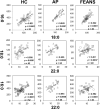Reduced Levels and Disrupted Biosynthesis Pathways of Plasma Free Fatty Acids in First-Episode Antipsychotic-Naïve Schizophrenia Patients
- PMID: 32848558
- PMCID: PMC7403507
- DOI: 10.3389/fnins.2020.00784
Reduced Levels and Disrupted Biosynthesis Pathways of Plasma Free Fatty Acids in First-Episode Antipsychotic-Naïve Schizophrenia Patients
Abstract
Membrane phospholipid deficits have been well-documented in schizophrenia (SZ) patients. Free fatty acids (FFAs) partially come from the hydrolysis of membrane phospholipids and serve as the circulating pool of body fatty acids. These FFAs are involved in many important biochemical reactions such as membrane regeneration, oxidation, and prostaglandin production which may have important implications in SZ pathology. Thus, we compared plasma FFA levels and profiles among healthy controls (HCs), affective psychosis (AP) patients, and first-episode antipsychotic-naïve schizophrenia (FEANS) patients. A significant reduction of total FFAs levels was observed in SZ patients. Specifically, significant reductions of 16:0, 18:2n6c, and 20:4n6 levels were detected in FEANS patients but not in APs when compared with levels in HCs. Also, disrupted metabolism of fatty acids especially in saturated and n-6 fatty acid families were observed by comparing correlations between precursor and product fatty acid levels within each fatty acid family. These findings may suggest an increased demand of membrane regeneration, a homeostatic imbalance of fatty acid biosynthesis pathway and a potential indication of increased beta oxidation. Collectively, these findings could help us better understand the lipid metabolism with regard to SZ pathophysiology.
Keywords: antipsychotic-naïve; fatty acid pathway; first-episode schizophrenia; free fatty acids; plasma.
Copyright © 2020 Zhou, Long, Haas, Cai and Yao.
Figures





Similar articles
-
Abnormalities in the fatty acid composition of the postmortem orbitofrontal cortex of schizophrenic patients: gender differences and partial normalization with antipsychotic medications.Schizophr Res. 2007 Mar;91(1-3):37-50. doi: 10.1016/j.schres.2006.11.027. Epub 2007 Jan 19. Schizophr Res. 2007. PMID: 17236749 Free PMC article.
-
Disrupted leptin-fatty acid biosynthesis is an early manifestation of metabolic abnormalities in schizophrenia.World J Psychiatry. 2022 Jun 19;12(6):827-842. doi: 10.5498/wjp.v12.i6.827. eCollection 2022 Jun 19. World J Psychiatry. 2022. PMID: 35978970 Free PMC article.
-
Characterising phospholipids and free fatty acids in patients with schizophrenia: A case-control study.World J Biol Psychiatry. 2021 Mar;22(3):161-174. doi: 10.1080/15622975.2020.1769188. Epub 2020 Jul 17. World J Biol Psychiatry. 2021. PMID: 32677491
-
Phospholipid membrane abnormalities and reduced niacin skin flush response in schizophrenia.Psychiatr Danub. 2008 Sep;20(3):372-83. Psychiatr Danub. 2008. PMID: 18827766 Review.
-
From membrane phospholipid defects to altered neurotransmission: is arachidonic acid a nexus in the pathophysiology of schizophrenia?Prostaglandins Leukot Essent Fatty Acids. 2003 Dec;69(6):367-84. doi: 10.1016/j.plefa.2003.08.008. Prostaglandins Leukot Essent Fatty Acids. 2003. PMID: 14623490 Review.
Cited by
-
Reduced erythrocyte membrane polyunsaturated fatty acid levels indicate diminished treatment response in patients with multi- versus first-episode schizophrenia.Schizophrenia (Heidelb). 2022 Feb 25;8(1):7. doi: 10.1038/s41537-022-00214-2. Schizophrenia (Heidelb). 2022. PMID: 35217671 Free PMC article.
-
An Investigation of the Sodium Nitroprusside Effects on Serum Lipids in an Animal Model of Schizophrenia by the Magnetic Resonance Study.ACS Omega. 2024 Nov 25;9(49):48480-48487. doi: 10.1021/acsomega.4c07072. eCollection 2024 Dec 10. ACS Omega. 2024. PMID: 39676991 Free PMC article.
-
Lipids in Psychiatric Disorders: Functional and Potential Diagnostic Role as Blood Biomarkers.Metabolites. 2024 Jan 23;14(2):80. doi: 10.3390/metabo14020080. Metabolites. 2024. PMID: 38392971 Free PMC article. Review.
-
Current State of Fluid Lipid Biomarkers for Personalized Diagnostics and Therapeutics in Schizophrenia Spectrum Disorders and Related Psychoses: A Narrative Review.Front Psychiatry. 2022 May 27;13:885904. doi: 10.3389/fpsyt.2022.885904. eCollection 2022. Front Psychiatry. 2022. PMID: 35711577 Free PMC article. Review.
-
Retinal electrophysiology in central nervous system disorders. A review of human and mouse studies.Front Neurosci. 2023 Aug 2;17:1215097. doi: 10.3389/fnins.2023.1215097. eCollection 2023. Front Neurosci. 2023. PMID: 37600004 Free PMC article. Review.
References
Grants and funding
LinkOut - more resources
Full Text Sources
Miscellaneous

